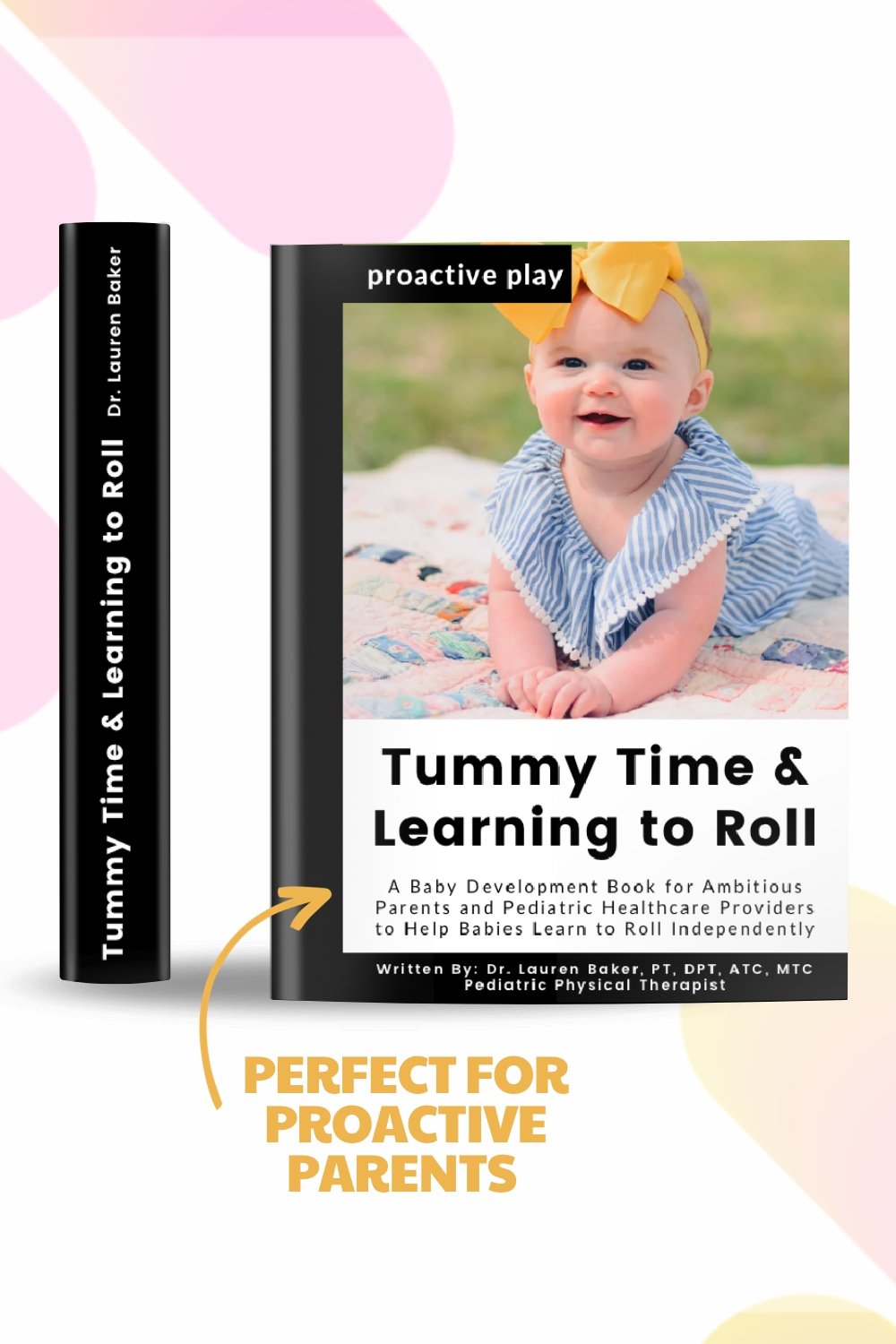Is Your Infant Not Rolling Over?
this blog contains affiliate links
Hello, proactive parents! I'm Dr. Lauren Baker, a pediatric physical therapist, and today I'm thrilled to share with you some valuable insights into helping your little one master the art of rolling both back to belly AND belly to back. This fundamental skill is not only exciting to witness but also crucial for your baby's physical development. Let's dive into how you can support your baby in learning to roll, breaking down this complex movement into manageable, understandable parts. For the most comprehensive information, make sure to watch the youtube video linked below!
Understanding the Basics of Rolling
Rolling is a significant milestone in your baby's development. It's the first real movement that shows your baby is starting to interact with their environment in a new and dynamic way.
Rolling involves being able to move the upper part of the body separately from the lower part, a skill necessary for many future movements, including walking.
Think of it like when you are lying on the ground and you bring your knees to one side, while keeping both your shoulders on the ground – you are moving your bottom half of your body BUT NOT the top half of the body.
If there is tightness anywhere along the way, you may not be able to bring your knees all the way to the ground while simultaneously keep your shoulders on the ground. It could also be different side to side. This is the same in babies and can keep them from being able to roll in all four directions.
Why Rolling Matters
Rolling is not just about moving from back to belly and vice versa; it's about ensuring your baby can do so in all four directions:
Back to belly to the right
Back to belly to the left
Belly to back to the right
Belly to back to the left
This symmetry in movement is crucial for developing balanced muscle strength and coordination. Asymmetries in rolling could lead to challenges with more complex skills down the line, such as crawling and walking.
Often babies who struggle with rolling or only do so in one direction (back to belly to left / belly to back to right and vice versa), are more at risk for developing non-optimal crawling patterns:
Belly crawling > 2 months
Booty scooting
Hitch crawling
Breaking Down the Roll
To understand how to help your baby roll, let's break it down into simpler components. Remember, this movement involves coordinating the upper and lower halves of the body, each playing a distinct role in the process. The video linked below will give you the most comprehensive understanding of how to help your baby roll in all four directions.
TIMESTAMPS:
0:30 Breaking Down Rolling
2:04 Rolling using your own body to learn
6:24 Rolling with your baby using model “baby eric”
10:43 How rolling affects walking
TOY IDEAS:
Best Toys for Babies Learning to Roll
Best Toys for Babies
PT Approved Equipment/Containers for Babies
Tummy Time Toys
Step-by-Step Guide to Rolling
Start on the Ground: Begin by lying on the ground to mimic the movements yourself. This will give you a firsthand understanding of the mechanics involved. It will also help you better understand what part of the process your baby might be getting stuck at.
Position the Arms: Ensure one arm is up and out of the way to prevent it from getting trapped underneath the body during the roll.
Initiate the Roll: Bend the opposite knee (to the side you're rolling towards) and bring it across your body. This movement starts the rotation of the pelvis, a key component in rolling.
Upper Body Coordination: As the lower body initiates the roll, the upper body needs to follow. This involves rotating the trunk and using the arms to assist in completing the roll. The arm opposite of the direction you’re rolling needs to come across the body toward the raised arm.
Repeat in Both Directions: Practice rolling to both the right and left sides to promote balanced muscle development.
Practical Tips for Helping Your Baby Roll
When working with your baby on rolling, the goal is to facilitate movement without forcing it. Here are some strategies to encourage rolling:
Pre-Positioning: Gently position your baby's arms and legs to prepare them for rolling.
Encourage Movement: Use toys or visual cues to encourage your baby to turn their head and follow with their body. Bringing toys toward the hand or making the toy make noise so that they are looking toward the direction of the roll can help them stay engaged.
Guide Gently: Provide gentle guidance at the pelvis or shoulders to help initiate the roll.
Promote Symmetry: Work on rolling in both directions to ensure balanced development.
The Connection Between Rolling and Walking
You might wonder how rolling is related to walking. The ability to disassociate the upper and lower parts of the body, as practiced in rolling, is foundational for walking. The pelvis's rotation during rolling mirrors the pelvic motion needed for walking.
When we are standing still, our pelvis is able to be still as well. When we go to walk forward, as our leg moves forward our pelvis tilts backwards as well as forward to a small degree.
The best way to visualize this is to place both of your hands on your pelvis and notice if one hand moves forward as your leg moves forward, then as you bring the other leg to pass that side of the pelvis will move forward, kind of like a forward/backward teeter totter.
The same happens when babies are rolling, except instead of being upright they are lying on their sides. If a baby struggles with rotating their pelvis while lying on the ground (easier) they will be at risk of struggling to complete against gravity in standing (harder).
Ensuring your baby masters rolling on both sides can facilitate the development of walking skills by promoting mobility, strength, and coordination.
Curious About Learning More on Tummy Time, Rolling, or Both?
The absolute best book for parents on tummy time and rolling is: Tummy Time and Learning to Roll: A Baby Development Book for Ambitious Parents and Pediatric Healthcare Providers to Help Babies Learn to Roll Independently. The book comes with a free online video course to help parents fully understand how to complete the different exercises, printable checklists to know exactly where your baby is at, and when to reach out for additional help.
This book was written by Dr. Lauren Baker, PT, DPT, ATC, MTC, who is a Pediatric Physical Therapist in Boise, Idaho, trained in helping parents learn how to help their babies move and master their milestones. She loves teaching parents how to see how their babies are moving as well as how to influence those movements though play positions and exercises to help babies move with confidence and ease.
Tummy Time and Learning to Roll is the first book in the Proactive Play series written by Pediatric Physical Therapist Dr. Lauren Baker in order to help Ambitious Parents and Pediatric Healthcare Providers learn how to help babies master tummy time and learn to roll. It is meant to help ambitious parents understand baby development from birth to six months (tummy time to rolling).
This book is a mix of easy-to-follow and more in-depth information than is typically found in baby development books because Dr. Baker believes parents deserve to have all the information at their fingertips.
This book breaks down each piece of movement in checklists so that parents know what their babies need for tummy time and rolling. It also covers what areas might limit a child with rolling, why it is so important, and when to seek help from a pediatric PT.
This book comes with colored photos and easy-to-follow demonstration videos that can help parents implement safe, strategic play-based exercises with their babies in 20 minutes per day.
A Great Resource For:
Parents and Pediatric Healthcare Providers of babies 0-6 months
Parents of babies who are struggling with tummy time, rolling back to belly, belly to back, or only to one side
Access to simple, easy-to-follow videos of play positions and exercises
Learning the four pillars of movement needed in order to master rolling
240+ Color Photo Examples of:
Tummy Time, Sidelying, and Back Play
Developmental Toys and Equipment
Hand Placement and Strategic Play Positions
Common Areas of Restriction or Weakness
When To Reach Out For Help
What If You Want Extra Help?
If you have concerns about their movement, remember, you can always reach out to a pediatric physical therapist. It's your right as a parent to advocate for your child's development.
Sometimes, a few tips and tricks are all you need to get your baby moving better. We're here to support you and release those mama worries. If you are looking for in home pediatric physical therapy, check our listing of therapists.
For those eager to learn more or seeking personalized guidance, I offer online video parent consultations internationally which can be scheduled by clicking here. I am dedicated to answering questions and providing tailored play activities for each unique developmental journey.
When Should Babies Receive Pediatric Physical Therapy?
Parents can call and schedule with a Pediatric Physical Therapist at any time, for any concern in all fifty states without a referral from their Pediatrician.
Pediatric Physical Therapy is medically indicated in all babies who are not rolling in all four directions by six months (back to belly over their right arm AND left arm + belly to back over their right arm AND left arm).
Pediatric Physical Therapy is medically indicated if you notice a flat spot on the back of an infants head (possible plagiocephaly), a tilt of their head consistently to one side (ear to shoulder - possible torticollis), or a rotation preference of their neck (consistently look only to the right or left - possible torticollis).
Many Pediatric Physical Therapists including Dr. Baker, can successfully treat flat spots (Plagiocephaly) without a helmet with a combination of therapy and positioning strategies if seen prior to 4 months (0-3 months is ideal). Dr. Baker uses the Baby Begin Method of repositioning.
Flat spots can be due to in-utero positioning, rotational preference (right sided flatness most common) and babies are at an increased risk for flatness if they are male, were breech, multiple birth, premature, have difficulty with tummy time, or are in containers > 2 hr/day.
Final Thoughts
As a pediatric physical therapist, I cannot stress enough the importance of early motor skills development. Rolling is a fundamental milestone that sets the stage for future movements.
By understanding the mechanics of rolling and actively supporting your baby through this phase, you're not only fostering physical development but also nurturing their confidence in exploring the world around them.
Thank you for joining me on this journey to help your baby master the art of rolling. Remember, every baby is unique, and they will reach milestones at their own pace. Celebrate the small victories, and enjoy this special time with your little one.
If you found this guide helpful, please consider subscribing to my channel for more insights into your baby's development. Let's help our little ones grow strong, balanced, and ready for their next big adventure!







